Mental Health and Nursing Practice
VerifiedAdded on 2020/03/16
|13
|3201
|79
AI Summary
This assignment delves into the crucial intersection of mental health and nursing practice. It examines various aspects of mental illness, including its prevalence, diagnosis, and treatment. The assignment emphasizes the importance of cultural competence and understanding the stigma surrounding mental health. Furthermore, it analyzes the role of nurses in providing holistic care to individuals experiencing mental health challenges, encompassing psychological support, medication management, and advocacy.
Contribute Materials
Your contribution can guide someone’s learning journey. Share your
documents today.
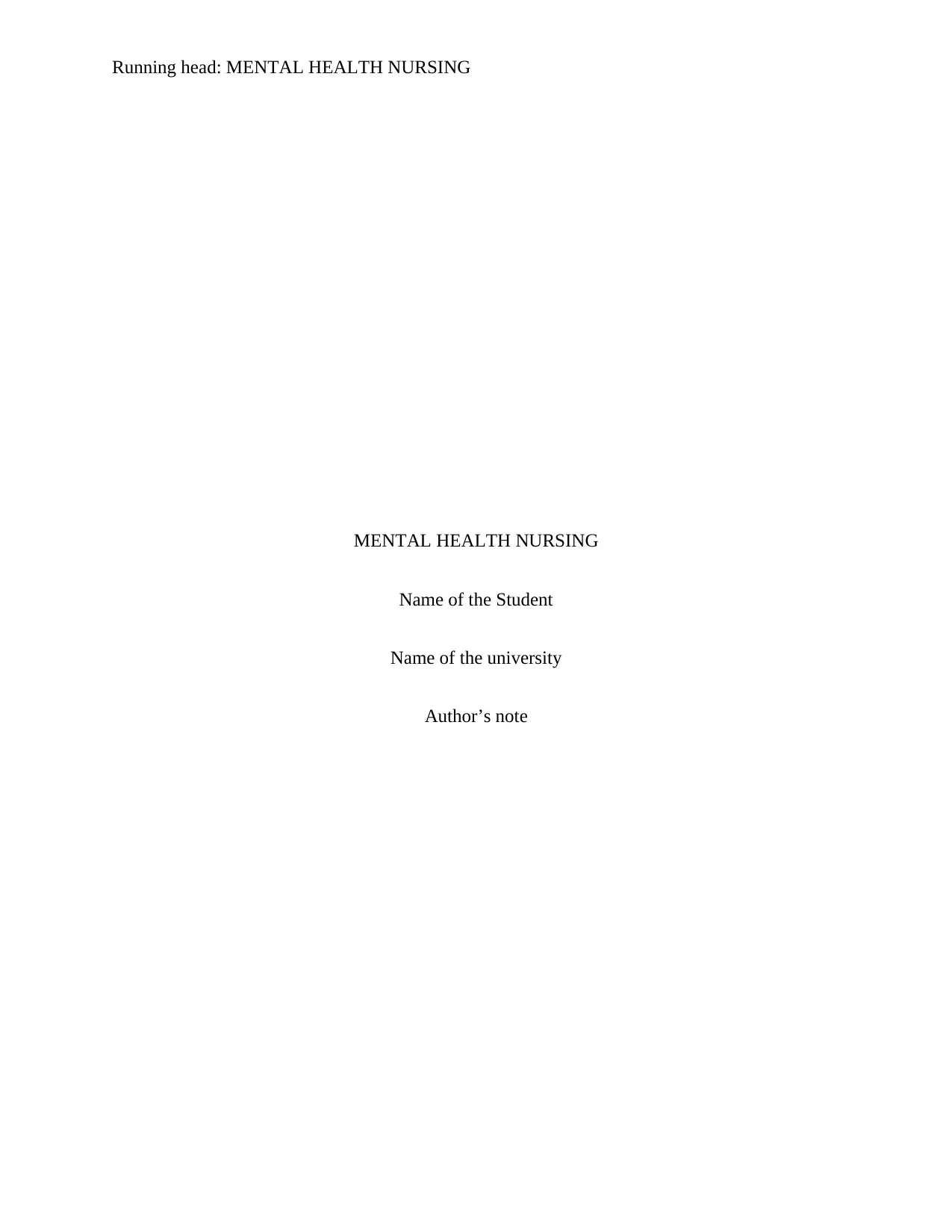
Running head: MENTAL HEALTH NURSING
MENTAL HEALTH NURSING
Name of the Student
Name of the university
Author’s note
MENTAL HEALTH NURSING
Name of the Student
Name of the university
Author’s note
Secure Best Marks with AI Grader
Need help grading? Try our AI Grader for instant feedback on your assignments.

1MENTAL HEALTH NURSING
Introduction
Mental health nursing is challenging work that involves supporting a person’s recovery
and enabling them to have control over their life. This essay focuses on my role as a mental
health nurse in treating a 15 year old boy who had been suffering from acute depression and
anxiety. Adam lives with his parents and his sister. He loves riding bikes and mountain racing.
He adores his pet cat Roger and always cares for her. He was not addicted to any drugs or
alcohol. Adam is very much attached to his grandmother. He considers his sister to be the only
one who understands Adam. Adam dreams of becoming a pilot or a professional mountain bike
rider. It should be mentioned beforehand that Adam had been a victim of child sexual abuse by
his uncle. On discovering his misdeeds, his uncle was handed over to the cops. It was reported
that the sexual abuse took place with Adam for almost 9 months. Recently on hearing the news
of his uncle’s release from the jail, Adam has again re-entered in to depression and has often
attempted suicides. The whole essay is based on the recovery plan for Adam. This essay provides
with a mental health assessment of Adam which focuses on the predisposing, perpetuating,
precipitating and the protecting factors for this ailment.
The later portion of the essay also throws light upon the different nursing interventions for the
self management of the disease. The report also discusses bout the use of the dialectical therapies
in combination with the antipsychotics to treat the disorder.
MENTAL STATE ASSESSMENT OF JUSTIN
Background: Adam was a 15 years old teenager, who had been suffering from borderline
personality disorder. Adam stayed with his family. He was sexually abused by his uncle, when
he was only 5 years old. Adam has been receiving treatments for depression since he was 10
Introduction
Mental health nursing is challenging work that involves supporting a person’s recovery
and enabling them to have control over their life. This essay focuses on my role as a mental
health nurse in treating a 15 year old boy who had been suffering from acute depression and
anxiety. Adam lives with his parents and his sister. He loves riding bikes and mountain racing.
He adores his pet cat Roger and always cares for her. He was not addicted to any drugs or
alcohol. Adam is very much attached to his grandmother. He considers his sister to be the only
one who understands Adam. Adam dreams of becoming a pilot or a professional mountain bike
rider. It should be mentioned beforehand that Adam had been a victim of child sexual abuse by
his uncle. On discovering his misdeeds, his uncle was handed over to the cops. It was reported
that the sexual abuse took place with Adam for almost 9 months. Recently on hearing the news
of his uncle’s release from the jail, Adam has again re-entered in to depression and has often
attempted suicides. The whole essay is based on the recovery plan for Adam. This essay provides
with a mental health assessment of Adam which focuses on the predisposing, perpetuating,
precipitating and the protecting factors for this ailment.
The later portion of the essay also throws light upon the different nursing interventions for the
self management of the disease. The report also discusses bout the use of the dialectical therapies
in combination with the antipsychotics to treat the disorder.
MENTAL STATE ASSESSMENT OF JUSTIN
Background: Adam was a 15 years old teenager, who had been suffering from borderline
personality disorder. Adam stayed with his family. He was sexually abused by his uncle, when
he was only 5 years old. Adam has been receiving treatments for depression since he was 10
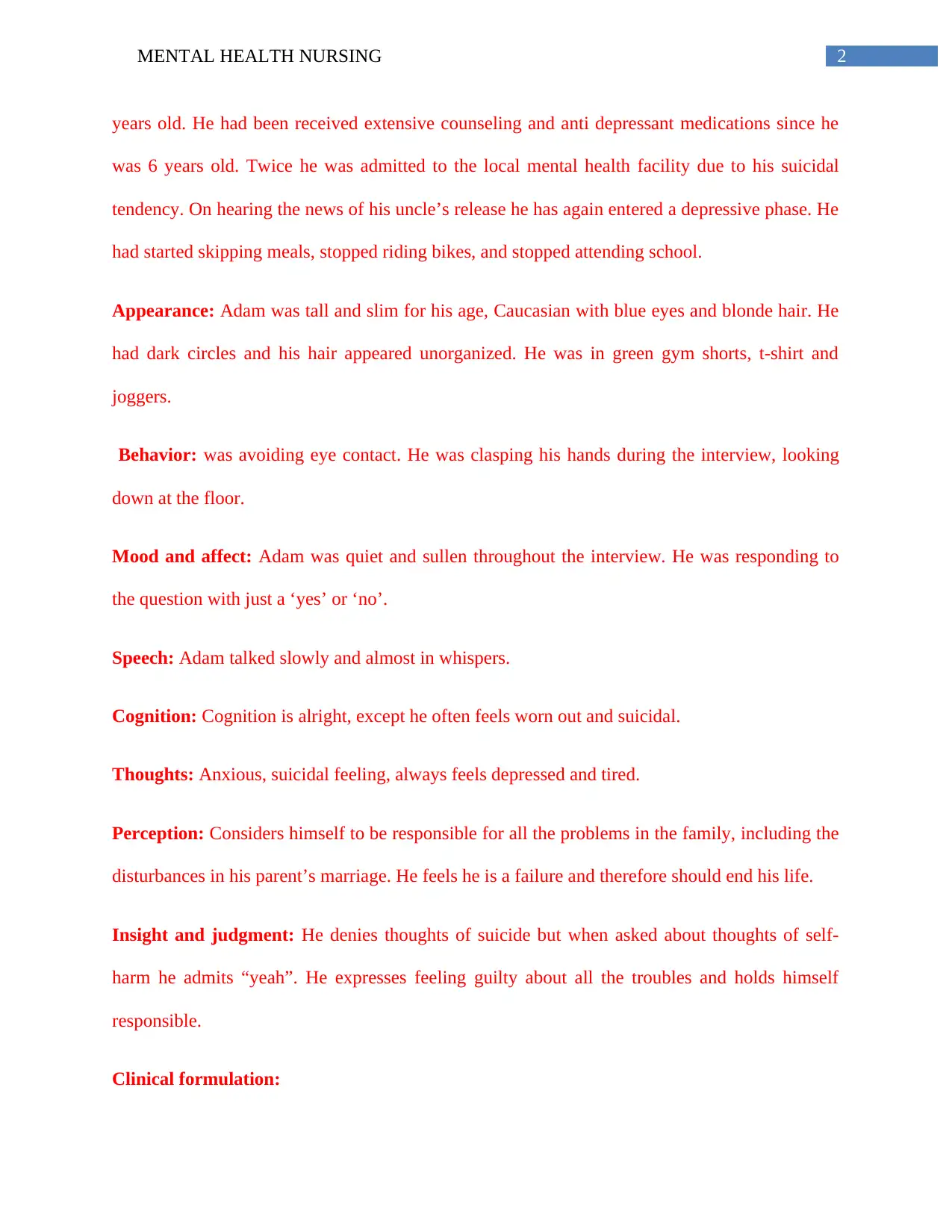
2MENTAL HEALTH NURSING
years old. He had been received extensive counseling and anti depressant medications since he
was 6 years old. Twice he was admitted to the local mental health facility due to his suicidal
tendency. On hearing the news of his uncle’s release he has again entered a depressive phase. He
had started skipping meals, stopped riding bikes, and stopped attending school.
Appearance: Adam was tall and slim for his age, Caucasian with blue eyes and blonde hair. He
had dark circles and his hair appeared unorganized. He was in green gym shorts, t-shirt and
joggers.
Behavior: was avoiding eye contact. He was clasping his hands during the interview, looking
down at the floor.
Mood and affect: Adam was quiet and sullen throughout the interview. He was responding to
the question with just a ‘yes’ or ‘no’.
Speech: Adam talked slowly and almost in whispers.
Cognition: Cognition is alright, except he often feels worn out and suicidal.
Thoughts: Anxious, suicidal feeling, always feels depressed and tired.
Perception: Considers himself to be responsible for all the problems in the family, including the
disturbances in his parent’s marriage. He feels he is a failure and therefore should end his life.
Insight and judgment: He denies thoughts of suicide but when asked about thoughts of self-
harm he admits “yeah”. He expresses feeling guilty about all the troubles and holds himself
responsible.
Clinical formulation:
years old. He had been received extensive counseling and anti depressant medications since he
was 6 years old. Twice he was admitted to the local mental health facility due to his suicidal
tendency. On hearing the news of his uncle’s release he has again entered a depressive phase. He
had started skipping meals, stopped riding bikes, and stopped attending school.
Appearance: Adam was tall and slim for his age, Caucasian with blue eyes and blonde hair. He
had dark circles and his hair appeared unorganized. He was in green gym shorts, t-shirt and
joggers.
Behavior: was avoiding eye contact. He was clasping his hands during the interview, looking
down at the floor.
Mood and affect: Adam was quiet and sullen throughout the interview. He was responding to
the question with just a ‘yes’ or ‘no’.
Speech: Adam talked slowly and almost in whispers.
Cognition: Cognition is alright, except he often feels worn out and suicidal.
Thoughts: Anxious, suicidal feeling, always feels depressed and tired.
Perception: Considers himself to be responsible for all the problems in the family, including the
disturbances in his parent’s marriage. He feels he is a failure and therefore should end his life.
Insight and judgment: He denies thoughts of suicide but when asked about thoughts of self-
harm he admits “yeah”. He expresses feeling guilty about all the troubles and holds himself
responsible.
Clinical formulation:
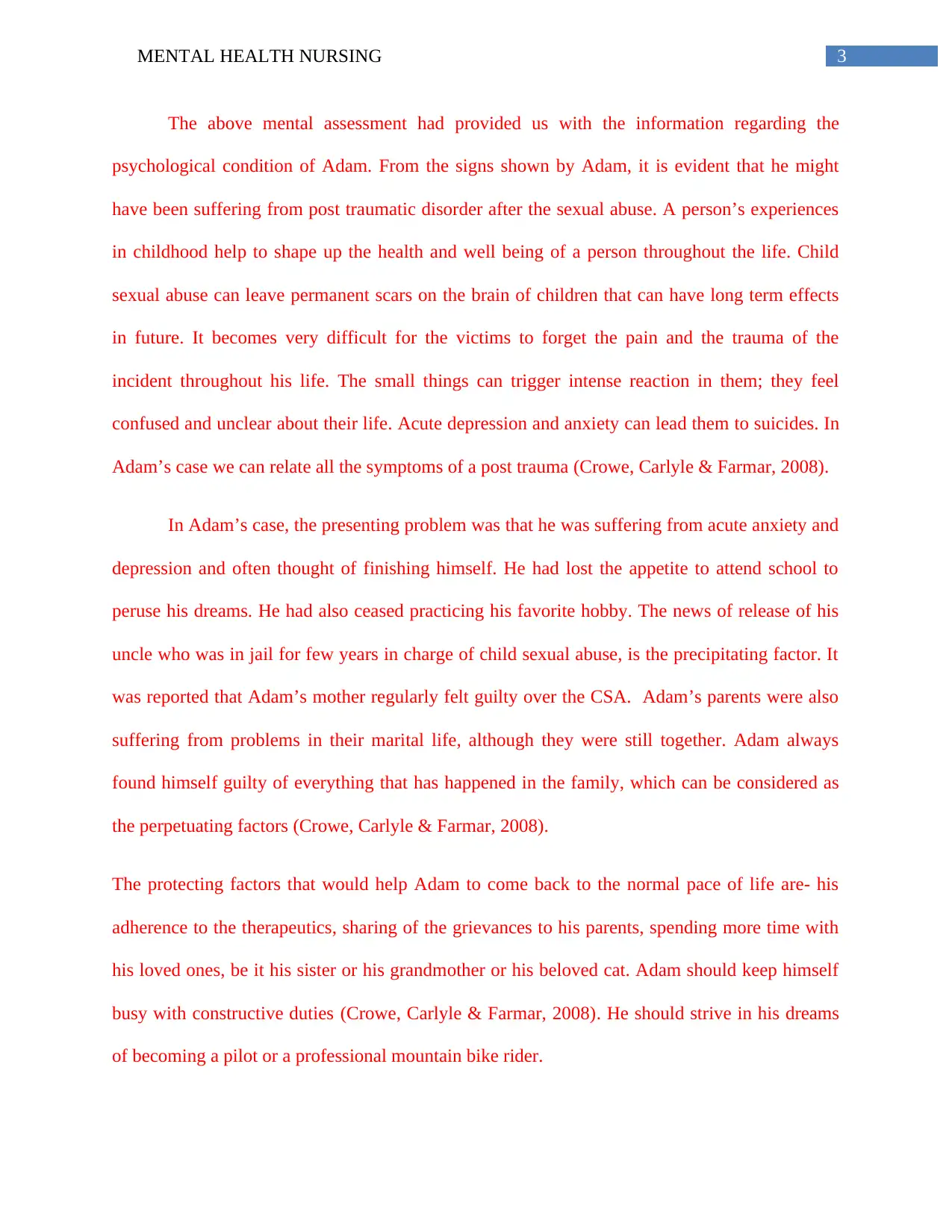
3MENTAL HEALTH NURSING
The above mental assessment had provided us with the information regarding the
psychological condition of Adam. From the signs shown by Adam, it is evident that he might
have been suffering from post traumatic disorder after the sexual abuse. A person’s experiences
in childhood help to shape up the health and well being of a person throughout the life. Child
sexual abuse can leave permanent scars on the brain of children that can have long term effects
in future. It becomes very difficult for the victims to forget the pain and the trauma of the
incident throughout his life. The small things can trigger intense reaction in them; they feel
confused and unclear about their life. Acute depression and anxiety can lead them to suicides. In
Adam’s case we can relate all the symptoms of a post trauma (Crowe, Carlyle & Farmar, 2008).
In Adam’s case, the presenting problem was that he was suffering from acute anxiety and
depression and often thought of finishing himself. He had lost the appetite to attend school to
peruse his dreams. He had also ceased practicing his favorite hobby. The news of release of his
uncle who was in jail for few years in charge of child sexual abuse, is the precipitating factor. It
was reported that Adam’s mother regularly felt guilty over the CSA. Adam’s parents were also
suffering from problems in their marital life, although they were still together. Adam always
found himself guilty of everything that has happened in the family, which can be considered as
the perpetuating factors (Crowe, Carlyle & Farmar, 2008).
The protecting factors that would help Adam to come back to the normal pace of life are- his
adherence to the therapeutics, sharing of the grievances to his parents, spending more time with
his loved ones, be it his sister or his grandmother or his beloved cat. Adam should keep himself
busy with constructive duties (Crowe, Carlyle & Farmar, 2008). He should strive in his dreams
of becoming a pilot or a professional mountain bike rider.
The above mental assessment had provided us with the information regarding the
psychological condition of Adam. From the signs shown by Adam, it is evident that he might
have been suffering from post traumatic disorder after the sexual abuse. A person’s experiences
in childhood help to shape up the health and well being of a person throughout the life. Child
sexual abuse can leave permanent scars on the brain of children that can have long term effects
in future. It becomes very difficult for the victims to forget the pain and the trauma of the
incident throughout his life. The small things can trigger intense reaction in them; they feel
confused and unclear about their life. Acute depression and anxiety can lead them to suicides. In
Adam’s case we can relate all the symptoms of a post trauma (Crowe, Carlyle & Farmar, 2008).
In Adam’s case, the presenting problem was that he was suffering from acute anxiety and
depression and often thought of finishing himself. He had lost the appetite to attend school to
peruse his dreams. He had also ceased practicing his favorite hobby. The news of release of his
uncle who was in jail for few years in charge of child sexual abuse, is the precipitating factor. It
was reported that Adam’s mother regularly felt guilty over the CSA. Adam’s parents were also
suffering from problems in their marital life, although they were still together. Adam always
found himself guilty of everything that has happened in the family, which can be considered as
the perpetuating factors (Crowe, Carlyle & Farmar, 2008).
The protecting factors that would help Adam to come back to the normal pace of life are- his
adherence to the therapeutics, sharing of the grievances to his parents, spending more time with
his loved ones, be it his sister or his grandmother or his beloved cat. Adam should keep himself
busy with constructive duties (Crowe, Carlyle & Farmar, 2008). He should strive in his dreams
of becoming a pilot or a professional mountain bike rider.
Secure Best Marks with AI Grader
Need help grading? Try our AI Grader for instant feedback on your assignments.
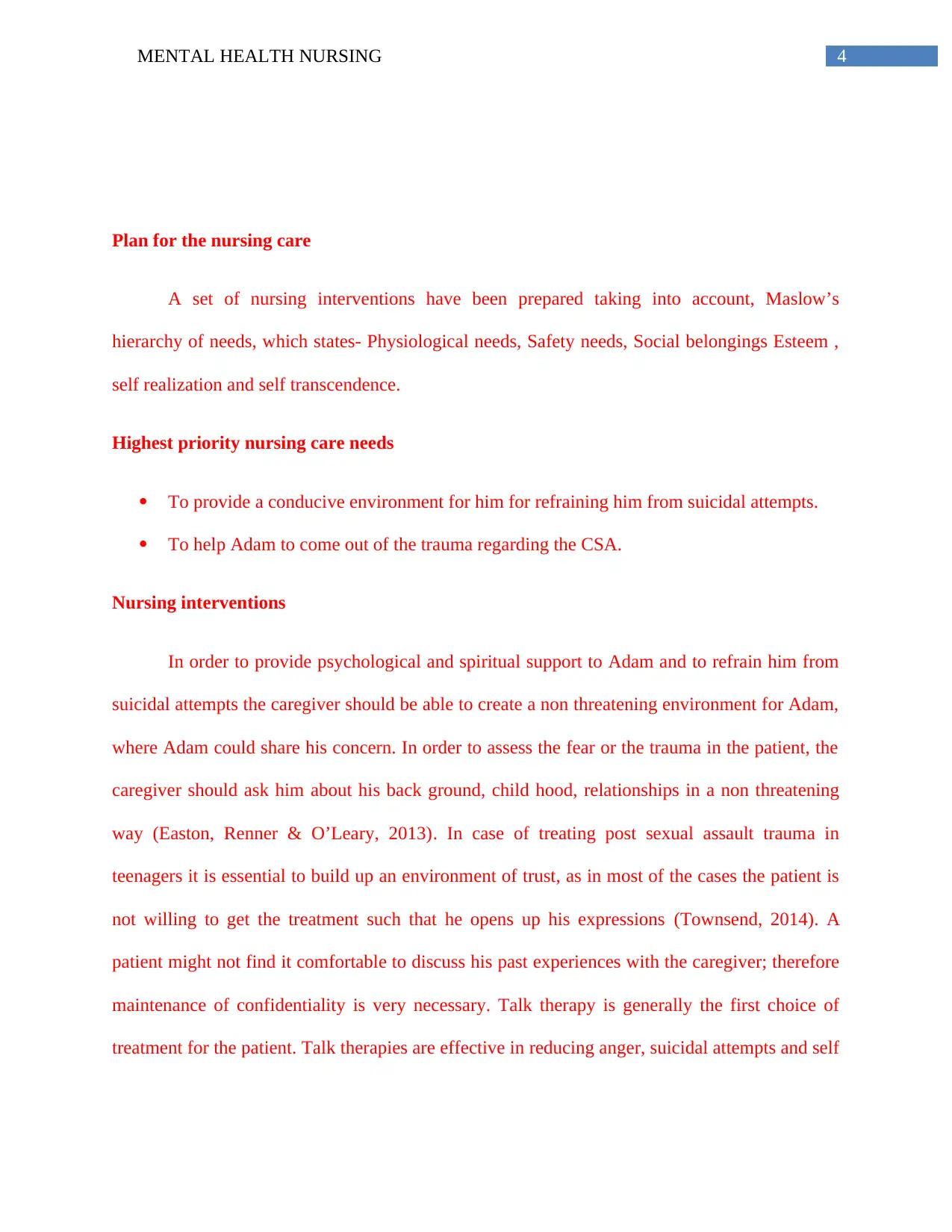
4MENTAL HEALTH NURSING
Plan for the nursing care
A set of nursing interventions have been prepared taking into account, Maslow’s
hierarchy of needs, which states- Physiological needs, Safety needs, Social belongings Esteem ,
self realization and self transcendence.
Highest priority nursing care needs
To provide a conducive environment for him for refraining him from suicidal attempts.
To help Adam to come out of the trauma regarding the CSA.
Nursing interventions
In order to provide psychological and spiritual support to Adam and to refrain him from
suicidal attempts the caregiver should be able to create a non threatening environment for Adam,
where Adam could share his concern. In order to assess the fear or the trauma in the patient, the
caregiver should ask him about his back ground, child hood, relationships in a non threatening
way (Easton, Renner & O’Leary, 2013). In case of treating post sexual assault trauma in
teenagers it is essential to build up an environment of trust, as in most of the cases the patient is
not willing to get the treatment such that he opens up his expressions (Townsend, 2014). A
patient might not find it comfortable to discuss his past experiences with the caregiver; therefore
maintenance of confidentiality is very necessary. Talk therapy is generally the first choice of
treatment for the patient. Talk therapies are effective in reducing anger, suicidal attempts and self
Plan for the nursing care
A set of nursing interventions have been prepared taking into account, Maslow’s
hierarchy of needs, which states- Physiological needs, Safety needs, Social belongings Esteem ,
self realization and self transcendence.
Highest priority nursing care needs
To provide a conducive environment for him for refraining him from suicidal attempts.
To help Adam to come out of the trauma regarding the CSA.
Nursing interventions
In order to provide psychological and spiritual support to Adam and to refrain him from
suicidal attempts the caregiver should be able to create a non threatening environment for Adam,
where Adam could share his concern. In order to assess the fear or the trauma in the patient, the
caregiver should ask him about his back ground, child hood, relationships in a non threatening
way (Easton, Renner & O’Leary, 2013). In case of treating post sexual assault trauma in
teenagers it is essential to build up an environment of trust, as in most of the cases the patient is
not willing to get the treatment such that he opens up his expressions (Townsend, 2014). A
patient might not find it comfortable to discuss his past experiences with the caregiver; therefore
maintenance of confidentiality is very necessary. Talk therapy is generally the first choice of
treatment for the patient. Talk therapies are effective in reducing anger, suicidal attempts and self
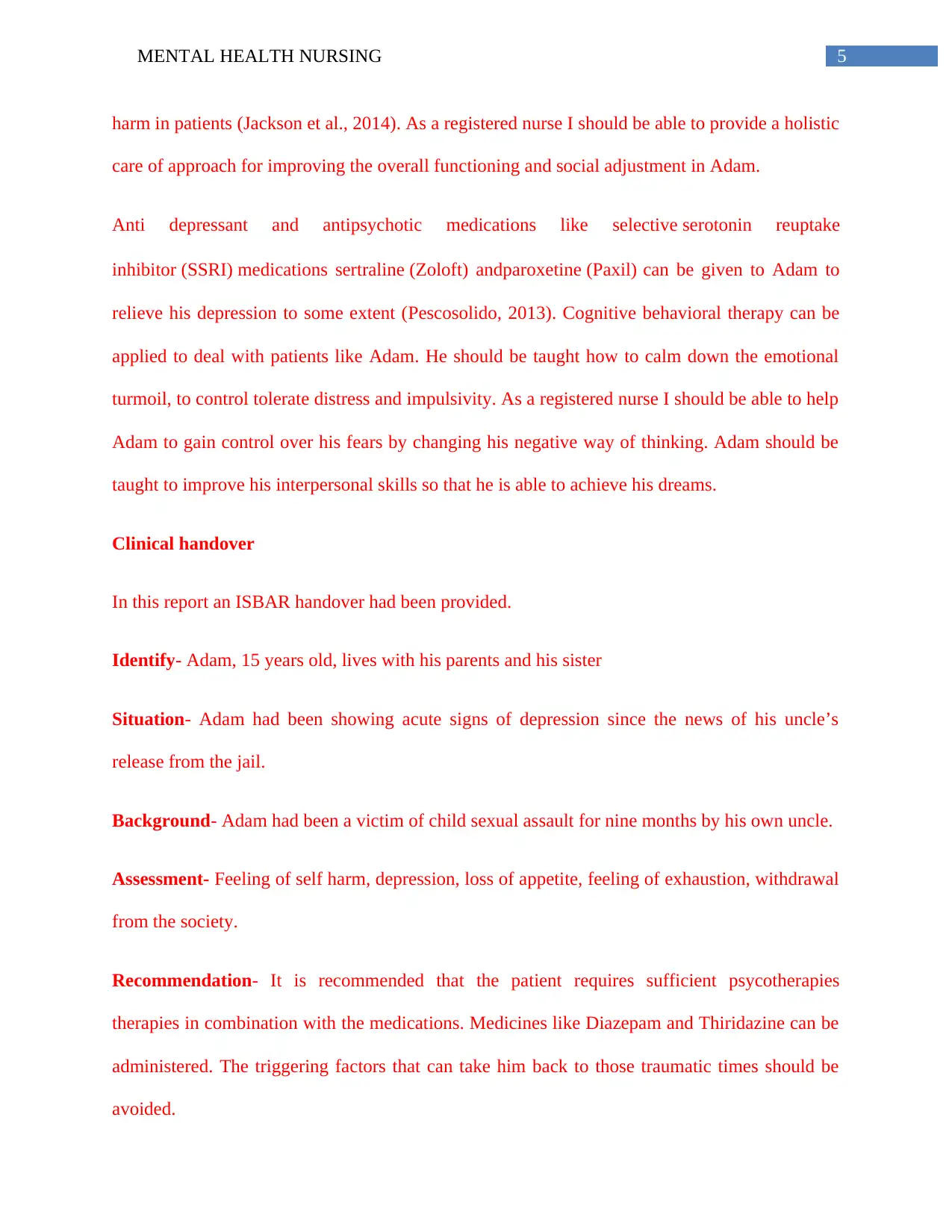
5MENTAL HEALTH NURSING
harm in patients (Jackson et al., 2014). As a registered nurse I should be able to provide a holistic
care of approach for improving the overall functioning and social adjustment in Adam.
Anti depressant and antipsychotic medications like selective serotonin reuptake
inhibitor (SSRI) medications sertraline (Zoloft) andparoxetine (Paxil) can be given to Adam to
relieve his depression to some extent (Pescosolido, 2013). Cognitive behavioral therapy can be
applied to deal with patients like Adam. He should be taught how to calm down the emotional
turmoil, to control tolerate distress and impulsivity. As a registered nurse I should be able to help
Adam to gain control over his fears by changing his negative way of thinking. Adam should be
taught to improve his interpersonal skills so that he is able to achieve his dreams.
Clinical handover
In this report an ISBAR handover had been provided.
Identify- Adam, 15 years old, lives with his parents and his sister
Situation- Adam had been showing acute signs of depression since the news of his uncle’s
release from the jail.
Background- Adam had been a victim of child sexual assault for nine months by his own uncle.
Assessment- Feeling of self harm, depression, loss of appetite, feeling of exhaustion, withdrawal
from the society.
Recommendation- It is recommended that the patient requires sufficient psycotherapies
therapies in combination with the medications. Medicines like Diazepam and Thiridazine can be
administered. The triggering factors that can take him back to those traumatic times should be
avoided.
harm in patients (Jackson et al., 2014). As a registered nurse I should be able to provide a holistic
care of approach for improving the overall functioning and social adjustment in Adam.
Anti depressant and antipsychotic medications like selective serotonin reuptake
inhibitor (SSRI) medications sertraline (Zoloft) andparoxetine (Paxil) can be given to Adam to
relieve his depression to some extent (Pescosolido, 2013). Cognitive behavioral therapy can be
applied to deal with patients like Adam. He should be taught how to calm down the emotional
turmoil, to control tolerate distress and impulsivity. As a registered nurse I should be able to help
Adam to gain control over his fears by changing his negative way of thinking. Adam should be
taught to improve his interpersonal skills so that he is able to achieve his dreams.
Clinical handover
In this report an ISBAR handover had been provided.
Identify- Adam, 15 years old, lives with his parents and his sister
Situation- Adam had been showing acute signs of depression since the news of his uncle’s
release from the jail.
Background- Adam had been a victim of child sexual assault for nine months by his own uncle.
Assessment- Feeling of self harm, depression, loss of appetite, feeling of exhaustion, withdrawal
from the society.
Recommendation- It is recommended that the patient requires sufficient psycotherapies
therapies in combination with the medications. Medicines like Diazepam and Thiridazine can be
administered. The triggering factors that can take him back to those traumatic times should be
avoided.

6MENTAL HEALTH NURSING
Paraphrase This Document
Need a fresh take? Get an instant paraphrase of this document with our AI Paraphraser
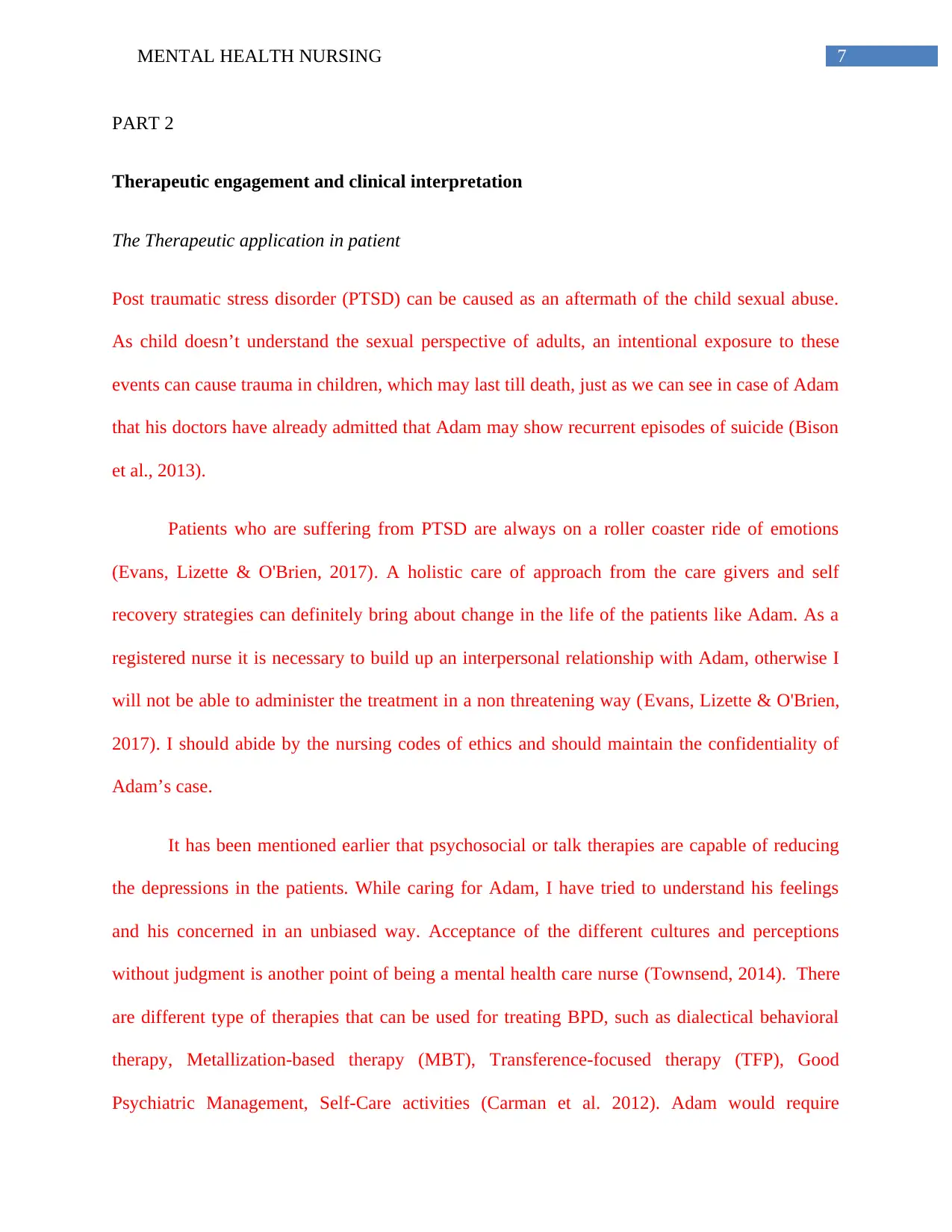
7MENTAL HEALTH NURSING
PART 2
Therapeutic engagement and clinical interpretation
The Therapeutic application in patient
Post traumatic stress disorder (PTSD) can be caused as an aftermath of the child sexual abuse.
As child doesn’t understand the sexual perspective of adults, an intentional exposure to these
events can cause trauma in children, which may last till death, just as we can see in case of Adam
that his doctors have already admitted that Adam may show recurrent episodes of suicide (Bison
et al., 2013).
Patients who are suffering from PTSD are always on a roller coaster ride of emotions
(Evans, Lizette & O'Brien, 2017). A holistic care of approach from the care givers and self
recovery strategies can definitely bring about change in the life of the patients like Adam. As a
registered nurse it is necessary to build up an interpersonal relationship with Adam, otherwise I
will not be able to administer the treatment in a non threatening way (Evans, Lizette & O'Brien,
2017). I should abide by the nursing codes of ethics and should maintain the confidentiality of
Adam’s case.
It has been mentioned earlier that psychosocial or talk therapies are capable of reducing
the depressions in the patients. While caring for Adam, I have tried to understand his feelings
and his concerned in an unbiased way. Acceptance of the different cultures and perceptions
without judgment is another point of being a mental health care nurse (Townsend, 2014). There
are different type of therapies that can be used for treating BPD, such as dialectical behavioral
therapy, Metallization-based therapy (MBT), Transference-focused therapy (TFP), Good
Psychiatric Management, Self-Care activities (Carman et al. 2012). Adam would require
PART 2
Therapeutic engagement and clinical interpretation
The Therapeutic application in patient
Post traumatic stress disorder (PTSD) can be caused as an aftermath of the child sexual abuse.
As child doesn’t understand the sexual perspective of adults, an intentional exposure to these
events can cause trauma in children, which may last till death, just as we can see in case of Adam
that his doctors have already admitted that Adam may show recurrent episodes of suicide (Bison
et al., 2013).
Patients who are suffering from PTSD are always on a roller coaster ride of emotions
(Evans, Lizette & O'Brien, 2017). A holistic care of approach from the care givers and self
recovery strategies can definitely bring about change in the life of the patients like Adam. As a
registered nurse it is necessary to build up an interpersonal relationship with Adam, otherwise I
will not be able to administer the treatment in a non threatening way (Evans, Lizette & O'Brien,
2017). I should abide by the nursing codes of ethics and should maintain the confidentiality of
Adam’s case.
It has been mentioned earlier that psychosocial or talk therapies are capable of reducing
the depressions in the patients. While caring for Adam, I have tried to understand his feelings
and his concerned in an unbiased way. Acceptance of the different cultures and perceptions
without judgment is another point of being a mental health care nurse (Townsend, 2014). There
are different type of therapies that can be used for treating BPD, such as dialectical behavioral
therapy, Metallization-based therapy (MBT), Transference-focused therapy (TFP), Good
Psychiatric Management, Self-Care activities (Carman et al. 2012). Adam would require
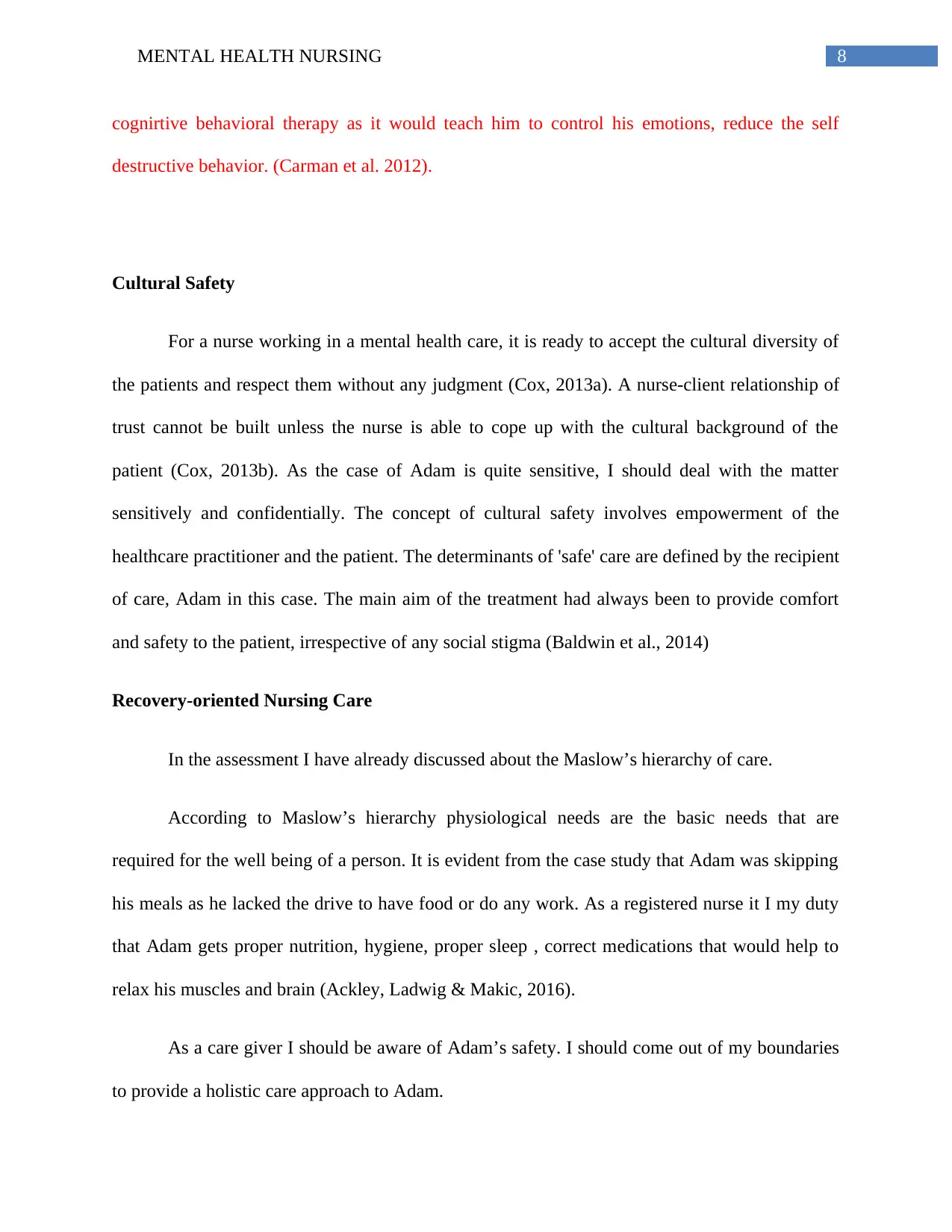
8MENTAL HEALTH NURSING
cognirtive behavioral therapy as it would teach him to control his emotions, reduce the self
destructive behavior. (Carman et al. 2012).
Cultural Safety
For a nurse working in a mental health care, it is ready to accept the cultural diversity of
the patients and respect them without any judgment (Cox, 2013a). A nurse-client relationship of
trust cannot be built unless the nurse is able to cope up with the cultural background of the
patient (Cox, 2013b). As the case of Adam is quite sensitive, I should deal with the matter
sensitively and confidentially. The concept of cultural safety involves empowerment of the
healthcare practitioner and the patient. The determinants of 'safe' care are defined by the recipient
of care, Adam in this case. The main aim of the treatment had always been to provide comfort
and safety to the patient, irrespective of any social stigma (Baldwin et al., 2014)
Recovery-oriented Nursing Care
In the assessment I have already discussed about the Maslow’s hierarchy of care.
According to Maslow’s hierarchy physiological needs are the basic needs that are
required for the well being of a person. It is evident from the case study that Adam was skipping
his meals as he lacked the drive to have food or do any work. As a registered nurse it I my duty
that Adam gets proper nutrition, hygiene, proper sleep , correct medications that would help to
relax his muscles and brain (Ackley, Ladwig & Makic, 2016).
As a care giver I should be aware of Adam’s safety. I should come out of my boundaries
to provide a holistic care approach to Adam.
cognirtive behavioral therapy as it would teach him to control his emotions, reduce the self
destructive behavior. (Carman et al. 2012).
Cultural Safety
For a nurse working in a mental health care, it is ready to accept the cultural diversity of
the patients and respect them without any judgment (Cox, 2013a). A nurse-client relationship of
trust cannot be built unless the nurse is able to cope up with the cultural background of the
patient (Cox, 2013b). As the case of Adam is quite sensitive, I should deal with the matter
sensitively and confidentially. The concept of cultural safety involves empowerment of the
healthcare practitioner and the patient. The determinants of 'safe' care are defined by the recipient
of care, Adam in this case. The main aim of the treatment had always been to provide comfort
and safety to the patient, irrespective of any social stigma (Baldwin et al., 2014)
Recovery-oriented Nursing Care
In the assessment I have already discussed about the Maslow’s hierarchy of care.
According to Maslow’s hierarchy physiological needs are the basic needs that are
required for the well being of a person. It is evident from the case study that Adam was skipping
his meals as he lacked the drive to have food or do any work. As a registered nurse it I my duty
that Adam gets proper nutrition, hygiene, proper sleep , correct medications that would help to
relax his muscles and brain (Ackley, Ladwig & Makic, 2016).
As a care giver I should be aware of Adam’s safety. I should come out of my boundaries
to provide a holistic care approach to Adam.
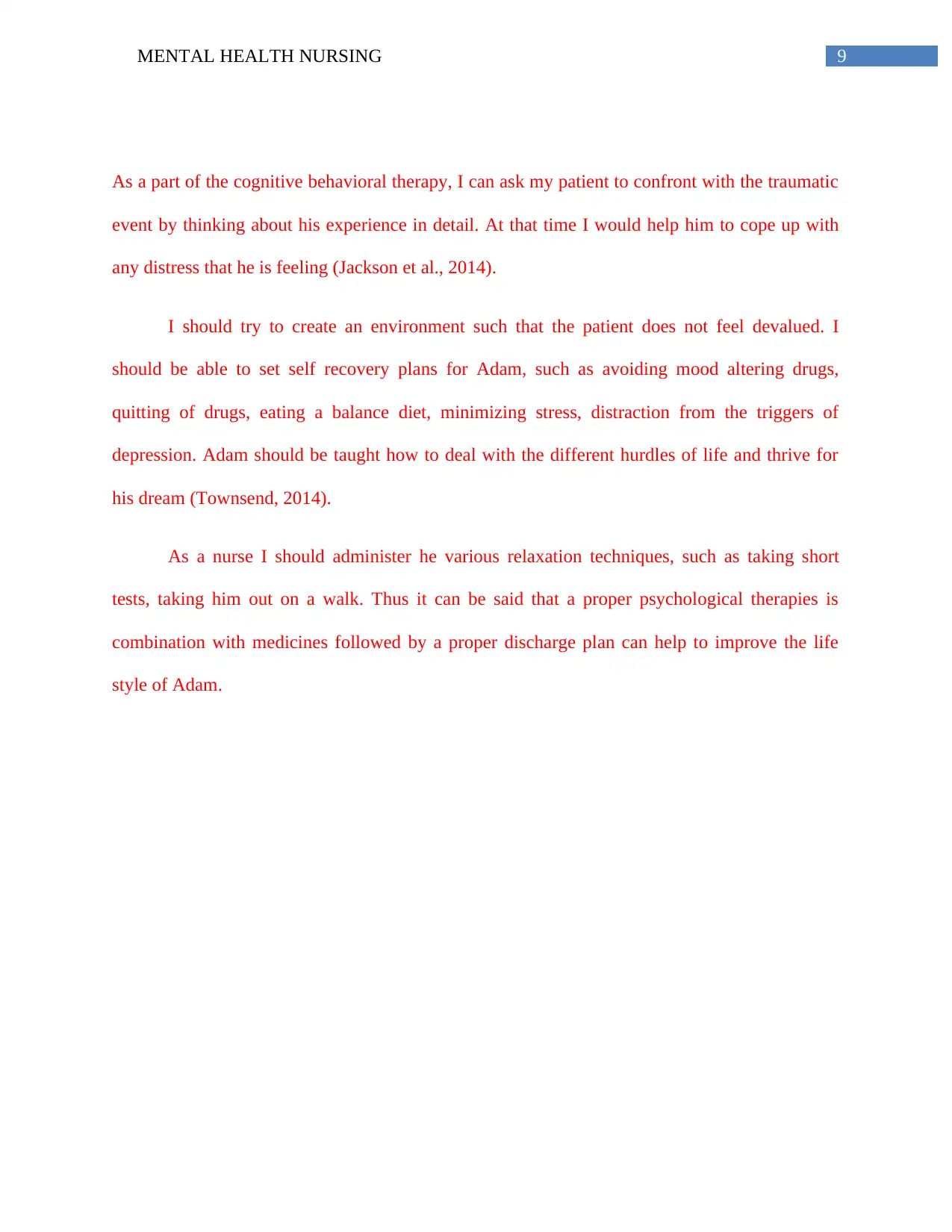
9MENTAL HEALTH NURSING
As a part of the cognitive behavioral therapy, I can ask my patient to confront with the traumatic
event by thinking about his experience in detail. At that time I would help him to cope up with
any distress that he is feeling (Jackson et al., 2014).
I should try to create an environment such that the patient does not feel devalued. I
should be able to set self recovery plans for Adam, such as avoiding mood altering drugs,
quitting of drugs, eating a balance diet, minimizing stress, distraction from the triggers of
depression. Adam should be taught how to deal with the different hurdles of life and thrive for
his dream (Townsend, 2014).
As a nurse I should administer he various relaxation techniques, such as taking short
tests, taking him out on a walk. Thus it can be said that a proper psychological therapies is
combination with medicines followed by a proper discharge plan can help to improve the life
style of Adam.
As a part of the cognitive behavioral therapy, I can ask my patient to confront with the traumatic
event by thinking about his experience in detail. At that time I would help him to cope up with
any distress that he is feeling (Jackson et al., 2014).
I should try to create an environment such that the patient does not feel devalued. I
should be able to set self recovery plans for Adam, such as avoiding mood altering drugs,
quitting of drugs, eating a balance diet, minimizing stress, distraction from the triggers of
depression. Adam should be taught how to deal with the different hurdles of life and thrive for
his dream (Townsend, 2014).
As a nurse I should administer he various relaxation techniques, such as taking short
tests, taking him out on a walk. Thus it can be said that a proper psychological therapies is
combination with medicines followed by a proper discharge plan can help to improve the life
style of Adam.
Secure Best Marks with AI Grader
Need help grading? Try our AI Grader for instant feedback on your assignments.

10MENTAL HEALTH NURSING
References
Ackley, B. J., Ladwig, G. B., & Makic, M. B. F. (2016). Nursing Diagnosis Handbook-E-Book:
An Evidence-Based Guide to Planning Care. Elsevier Health Sciences.
Angermeyer, M. C., &Matschinger, H. (2003). The stigma of mental illness: effects of labelling
on public attitudes towards people with mental disorder. Acta PsychiatricaScandinavica,
108(4), 304–309. doi:10.1034/j.1600-0447.2003.00150.x
Baldwin, D. S., Anderson, I. M., Nutt, D. J., Allgulander, C., Bandelow, B., den Boer, J. A., ... &
Malizia, A. (2014). Evidence-based pharmacological treatment of anxiety disorders, post-
traumatic stress disorder and obsessive-compulsive disorder: a revision of the 2005
guidelines from the British Association for Psychopharmacology. Journal of
Psychopharmacology, 28(5), 403-439. First Published April 8, 2014 Research Article.
Bisson, J. I., Roberts, N. P., Andrew, M., Cooper, R., & Lewis, C. (2013). Psychological
therapies for chronic post‐traumatic stress disorder (PTSD) in adults. The Cochrane
Library. DOI: 10.1002/14651858.CD003388.pub4
Cox, L. (2013a). Cultural Safety in Introducing mental health nursing: a service user-oriented
approach (2nd edition). Sydney: Allen & Unwin.
Cox, L. (2013b). Sociological understandings of mental health and Indigenous Social and
Emotional Well-being. In Introducing mental health nursing: a service user-oriented
approach (2nd edition). Sydney: Allen & Unwin.
References
Ackley, B. J., Ladwig, G. B., & Makic, M. B. F. (2016). Nursing Diagnosis Handbook-E-Book:
An Evidence-Based Guide to Planning Care. Elsevier Health Sciences.
Angermeyer, M. C., &Matschinger, H. (2003). The stigma of mental illness: effects of labelling
on public attitudes towards people with mental disorder. Acta PsychiatricaScandinavica,
108(4), 304–309. doi:10.1034/j.1600-0447.2003.00150.x
Baldwin, D. S., Anderson, I. M., Nutt, D. J., Allgulander, C., Bandelow, B., den Boer, J. A., ... &
Malizia, A. (2014). Evidence-based pharmacological treatment of anxiety disorders, post-
traumatic stress disorder and obsessive-compulsive disorder: a revision of the 2005
guidelines from the British Association for Psychopharmacology. Journal of
Psychopharmacology, 28(5), 403-439. First Published April 8, 2014 Research Article.
Bisson, J. I., Roberts, N. P., Andrew, M., Cooper, R., & Lewis, C. (2013). Psychological
therapies for chronic post‐traumatic stress disorder (PTSD) in adults. The Cochrane
Library. DOI: 10.1002/14651858.CD003388.pub4
Cox, L. (2013a). Cultural Safety in Introducing mental health nursing: a service user-oriented
approach (2nd edition). Sydney: Allen & Unwin.
Cox, L. (2013b). Sociological understandings of mental health and Indigenous Social and
Emotional Well-being. In Introducing mental health nursing: a service user-oriented
approach (2nd edition). Sydney: Allen & Unwin.
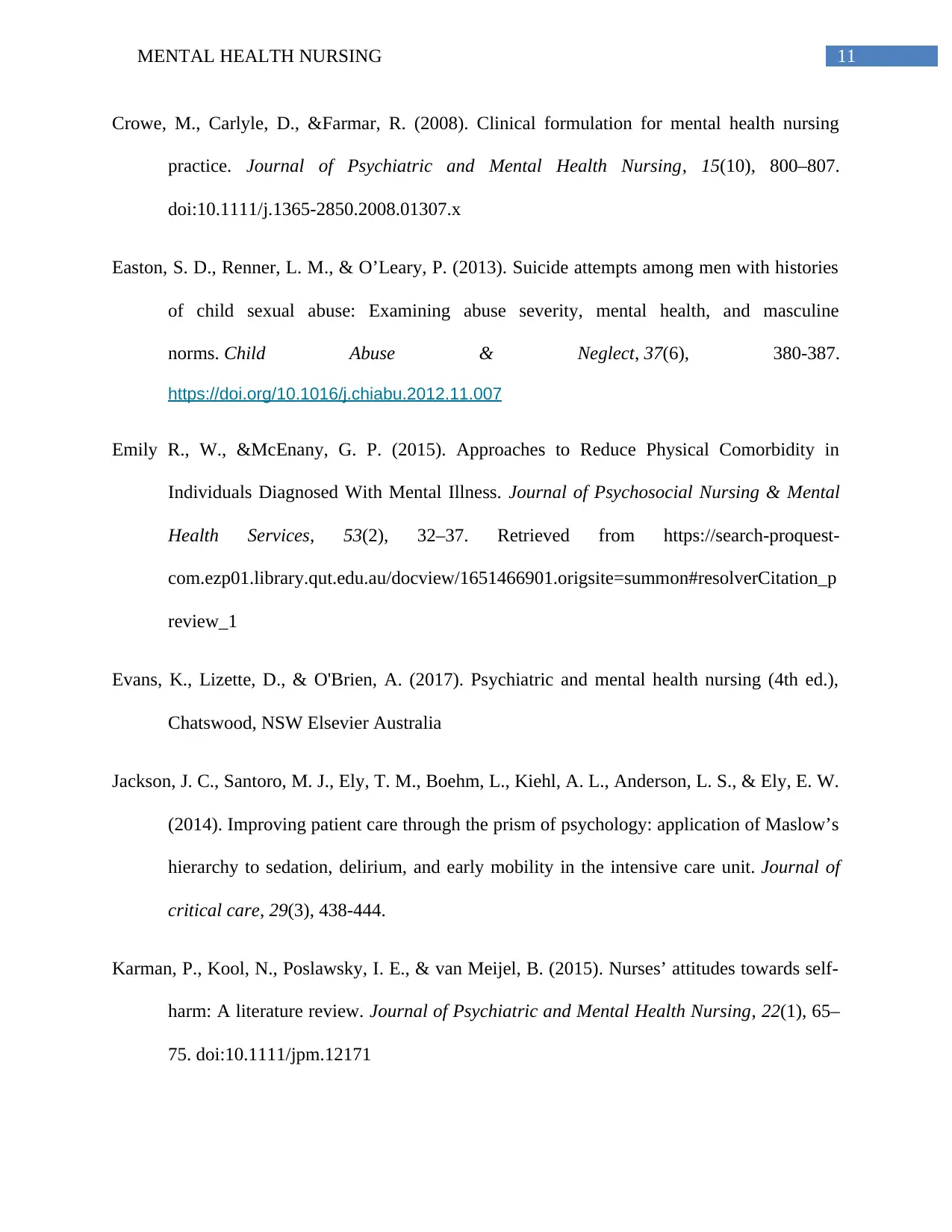
11MENTAL HEALTH NURSING
Crowe, M., Carlyle, D., &Farmar, R. (2008). Clinical formulation for mental health nursing
practice. Journal of Psychiatric and Mental Health Nursing, 15(10), 800–807.
doi:10.1111/j.1365-2850.2008.01307.x
Easton, S. D., Renner, L. M., & O’Leary, P. (2013). Suicide attempts among men with histories
of child sexual abuse: Examining abuse severity, mental health, and masculine
norms. Child Abuse & Neglect, 37(6), 380-387.
https://doi.org/10.1016/j.chiabu.2012.11.007
Emily R., W., &McEnany, G. P. (2015). Approaches to Reduce Physical Comorbidity in
Individuals Diagnosed With Mental Illness. Journal of Psychosocial Nursing & Mental
Health Services, 53(2), 32–37. Retrieved from https://search-proquest-
com.ezp01.library.qut.edu.au/docview/1651466901.origsite=summon#resolverCitation_p
review_1
Evans, K., Lizette, D., & O'Brien, A. (2017). Psychiatric and mental health nursing (4th ed.),
Chatswood, NSW Elsevier Australia
Jackson, J. C., Santoro, M. J., Ely, T. M., Boehm, L., Kiehl, A. L., Anderson, L. S., & Ely, E. W.
(2014). Improving patient care through the prism of psychology: application of Maslow’s
hierarchy to sedation, delirium, and early mobility in the intensive care unit. Journal of
critical care, 29(3), 438-444.
Karman, P., Kool, N., Poslawsky, I. E., & van Meijel, B. (2015). Nurses’ attitudes towards self-
harm: A literature review. Journal of Psychiatric and Mental Health Nursing, 22(1), 65–
75. doi:10.1111/jpm.12171
Crowe, M., Carlyle, D., &Farmar, R. (2008). Clinical formulation for mental health nursing
practice. Journal of Psychiatric and Mental Health Nursing, 15(10), 800–807.
doi:10.1111/j.1365-2850.2008.01307.x
Easton, S. D., Renner, L. M., & O’Leary, P. (2013). Suicide attempts among men with histories
of child sexual abuse: Examining abuse severity, mental health, and masculine
norms. Child Abuse & Neglect, 37(6), 380-387.
https://doi.org/10.1016/j.chiabu.2012.11.007
Emily R., W., &McEnany, G. P. (2015). Approaches to Reduce Physical Comorbidity in
Individuals Diagnosed With Mental Illness. Journal of Psychosocial Nursing & Mental
Health Services, 53(2), 32–37. Retrieved from https://search-proquest-
com.ezp01.library.qut.edu.au/docview/1651466901.origsite=summon#resolverCitation_p
review_1
Evans, K., Lizette, D., & O'Brien, A. (2017). Psychiatric and mental health nursing (4th ed.),
Chatswood, NSW Elsevier Australia
Jackson, J. C., Santoro, M. J., Ely, T. M., Boehm, L., Kiehl, A. L., Anderson, L. S., & Ely, E. W.
(2014). Improving patient care through the prism of psychology: application of Maslow’s
hierarchy to sedation, delirium, and early mobility in the intensive care unit. Journal of
critical care, 29(3), 438-444.
Karman, P., Kool, N., Poslawsky, I. E., & van Meijel, B. (2015). Nurses’ attitudes towards self-
harm: A literature review. Journal of Psychiatric and Mental Health Nursing, 22(1), 65–
75. doi:10.1111/jpm.12171
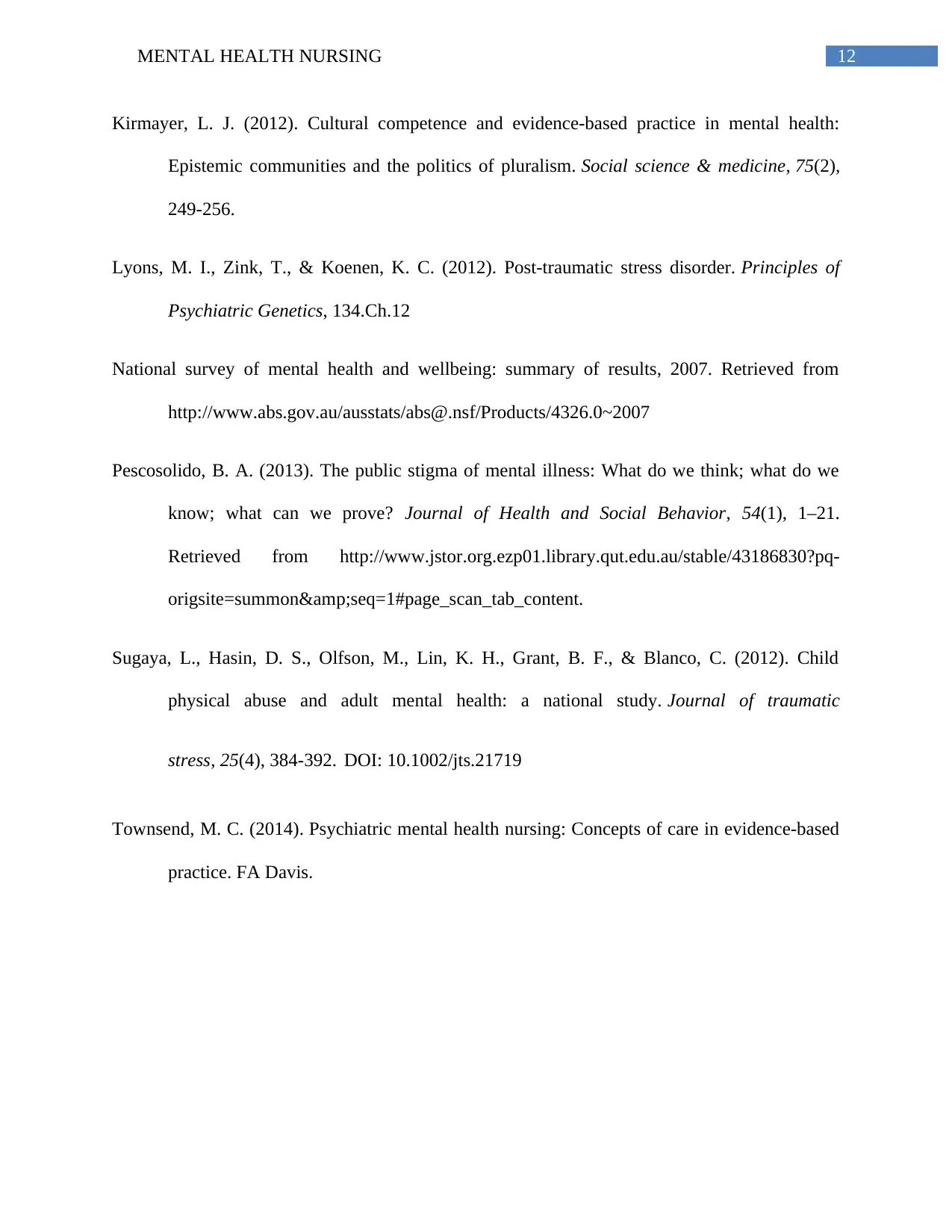
12MENTAL HEALTH NURSING
Kirmayer, L. J. (2012). Cultural competence and evidence-based practice in mental health:
Epistemic communities and the politics of pluralism. Social science & medicine, 75(2),
249-256.
Lyons, M. I., Zink, T., & Koenen, K. C. (2012). Post-traumatic stress disorder. Principles of
Psychiatric Genetics, 134.Ch.12
National survey of mental health and wellbeing: summary of results, 2007. Retrieved from
http://www.abs.gov.au/ausstats/abs@.nsf/Products/4326.0~2007
Pescosolido, B. A. (2013). The public stigma of mental illness: What do we think; what do we
know; what can we prove? Journal of Health and Social Behavior, 54(1), 1–21.
Retrieved from http://www.jstor.org.ezp01.library.qut.edu.au/stable/43186830?pq-
origsite=summon&seq=1#page_scan_tab_content.
Sugaya, L., Hasin, D. S., Olfson, M., Lin, K. H., Grant, B. F., & Blanco, C. (2012). Child
physical abuse and adult mental health: a national study. Journal of traumatic
stress, 25(4), 384-392. DOI: 10.1002/jts.21719
Townsend, M. C. (2014). Psychiatric mental health nursing: Concepts of care in evidence-based
practice. FA Davis.
Kirmayer, L. J. (2012). Cultural competence and evidence-based practice in mental health:
Epistemic communities and the politics of pluralism. Social science & medicine, 75(2),
249-256.
Lyons, M. I., Zink, T., & Koenen, K. C. (2012). Post-traumatic stress disorder. Principles of
Psychiatric Genetics, 134.Ch.12
National survey of mental health and wellbeing: summary of results, 2007. Retrieved from
http://www.abs.gov.au/ausstats/abs@.nsf/Products/4326.0~2007
Pescosolido, B. A. (2013). The public stigma of mental illness: What do we think; what do we
know; what can we prove? Journal of Health and Social Behavior, 54(1), 1–21.
Retrieved from http://www.jstor.org.ezp01.library.qut.edu.au/stable/43186830?pq-
origsite=summon&seq=1#page_scan_tab_content.
Sugaya, L., Hasin, D. S., Olfson, M., Lin, K. H., Grant, B. F., & Blanco, C. (2012). Child
physical abuse and adult mental health: a national study. Journal of traumatic
stress, 25(4), 384-392. DOI: 10.1002/jts.21719
Townsend, M. C. (2014). Psychiatric mental health nursing: Concepts of care in evidence-based
practice. FA Davis.
1 out of 13
Your All-in-One AI-Powered Toolkit for Academic Success.
+13062052269
info@desklib.com
Available 24*7 on WhatsApp / Email
![[object Object]](/_next/static/media/star-bottom.7253800d.svg)
Unlock your academic potential
© 2024 | Zucol Services PVT LTD | All rights reserved.





